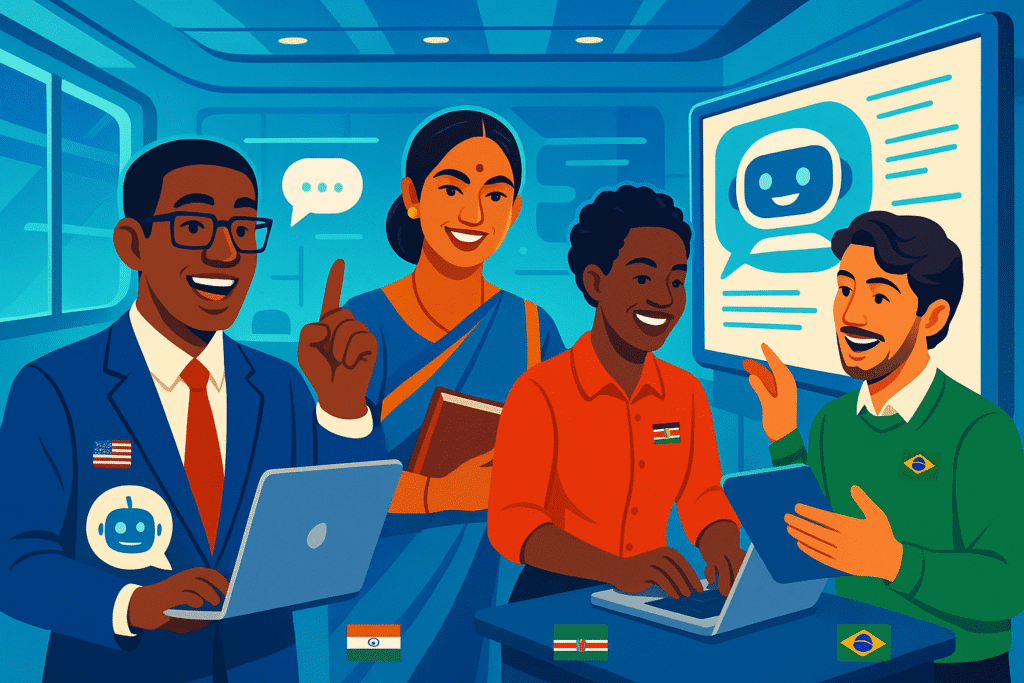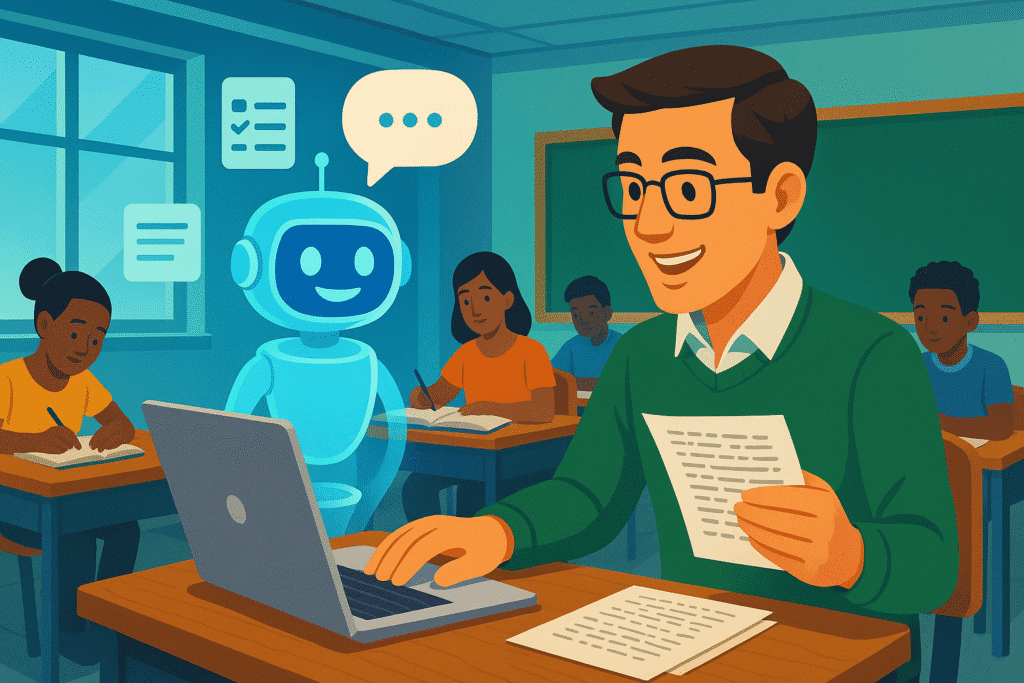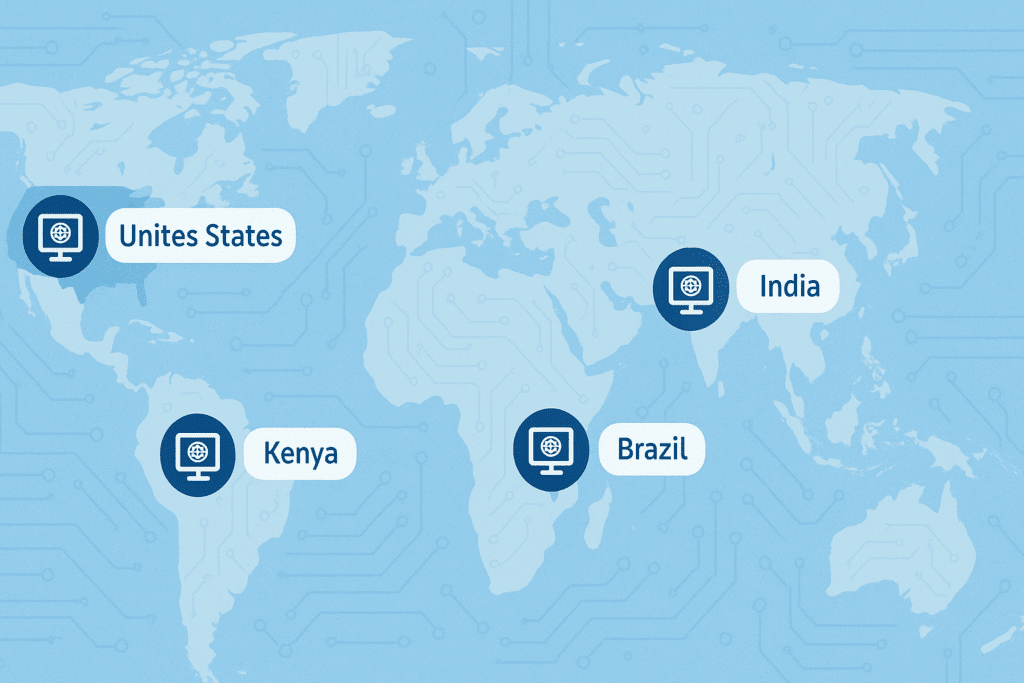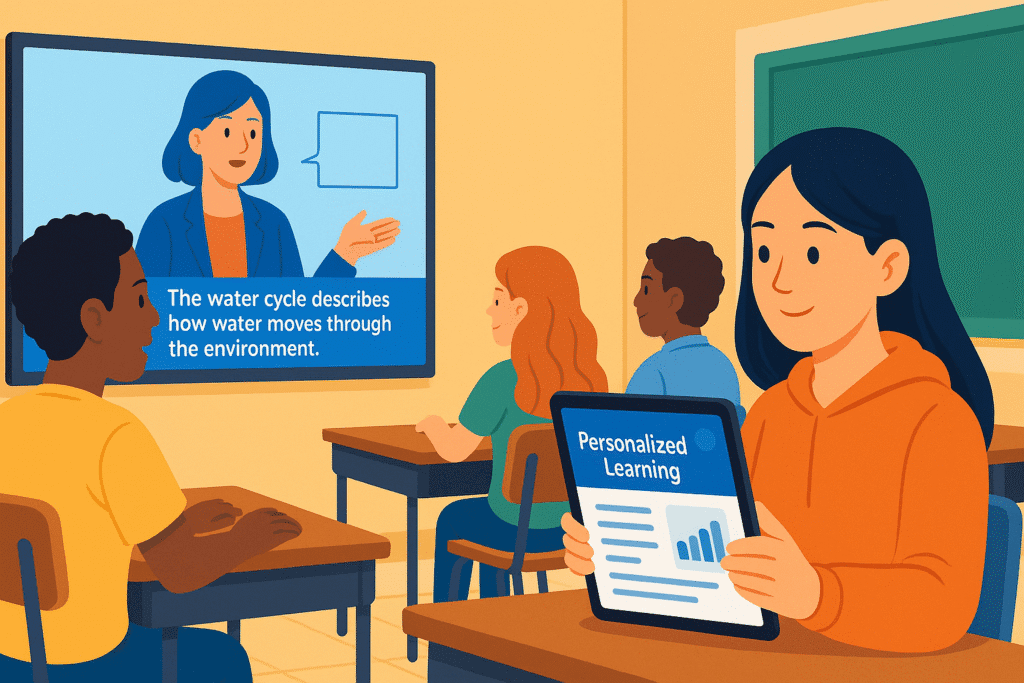
Education is undergoing a massive transformation, and technology is at the heart of this evolution. One of the most groundbreaking developments in recent years is the rise of AI tools for teachers, transforming classrooms across the globe. From bustling cities in the United States to rural villages in India, AI tools for teachers are reshaping how knowledge is shared, lessons are planned, and students are engaged.
Gone are the days when teachers relied solely on textbooks, blackboards, and long hours of manual grading. Today, AI offers educators powerful resources that automate repetitive tasks, deliver personalized learning experiences, and enhance classroom creativity. But with countless AI tools flooding the market, knowing which ones are truly effective can be overwhelming.
This comprehensive guide is designed to help educators worldwide—whether you teach in a high-tech school in Singapore or a community center in Kenya—discover the AI tools that can truly make a difference. We will explore the top 7 AI tools for teachers, delve into their real-world benefits, discuss potential challenges, and share additional free resources available to educators everywhere.
If you’re ready to save time, reduce stress, and elevate your teaching impact, read on to uncover how AI is revolutionizing education for teachers and students alike.
Why AI Tools for Teachers Are Revolutionizing Classrooms
Imagine this: A teacher in Brazil finishes grading a set of essays in minutes, not hours, thanks to AI-powered tools. Meanwhile, in South Africa, a student receives personalized math exercises based on their unique learning gaps, all generated by AI. Across the globe, from the United States to Nigeria to Japan, artificial intelligence is quietly reshaping classrooms in ways that would have seemed impossible a decade ago.
Supporting Teachers, Not Replacing Them
First, it’s important to address a common misconception: AI is not here to replace teachers. Great educators inspire, guide, and connect with students in ways no machine ever can. Instead, AI tools act as virtual teaching assistants, helping educators manage time-consuming tasks and focus more on teaching. With the right AI tools for teachers, educators can reduce administrative burden and focus on what they do best — inspiring students.

Take for example Ms. Amina, a high school English teacher in Nairobi, Kenya. With over 200 students and limited resources, keeping up with grading, lesson planning, and individual feedback felt overwhelming. By integrating tools like Grammarly and ChatGPT into her workflow, she now generates writing prompts, provides instant grammar feedback, and even receives AI-powered suggestions to improve her lesson structure. As a result, her students’ writing skills have improved significantly, and she has more time for creative classroom activities.
Real-World Impacts Across Continents
- In Canada, teachers use AI-driven platforms like Quizlet to create interactive learning games, turning dull revision sessions into exciting challenges for students.
- In India, schools adopt Khan Academy’s AI recommendations to provide personalized learning pathways, helping students in remote areas access quality education tailored to their needs.
- In Germany, AI transcription tools like Otter.ai help teachers instantly convert spoken lessons into written text, improving accessibility for students with hearing impairments or language barriers.
Across countries like Brazil, South Africa, and Japan, AI tools for teachers are driving improvements in accessibility and engagement.
Quick Statistics to Show the Global Shift
- Over 60% of teachers worldwide now report using at least one AI tool regularly in their classrooms.
- Studies show that AI-powered grading tools can reduce grading time by up to 50%, freeing educators to focus on lesson delivery.
- According to a World Economic Forum report, 70% of educators believe AI helps make learning more personalized and inclusive.
- Recent studies confirm that AI tools for teachers have a direct impact on reducing grading time and improving lesson personalization.
In short, AI tools are not a passing trend—they are fundamentally reshaping classrooms, improving student outcomes, and making teachers’ lives easier, no matter where in the world they teach.
7 AI Tools for Teachers You Can’t Afford to Miss
7 AI Tools for Teachers You Can’t Afford to Miss
Across classrooms from London to Lagos, from Tokyo to Toronto, AI tools are becoming essential companions for modern educators. These tools don’t just save time—they enhance learning, promote creativity, and personalize education for students everywhere. Below are seven of the most powerful, globally accessible AI tools every teacher should explore.

1. ChatGPT — Your AI-Powered Teaching Assistant
ChatGPT by OpenAI is transforming how teachers approach lesson planning, content creation, and student support. This conversational AI can:
✅ Generate lesson plans based on grade level and subject.
✅ Simplify complex topics for different age groups.
✅ Provide examples, summaries, and creative writing prompts.
✅ Answer common student questions instantly.
2. Grammarly — Smarter Writing for Students and Teachers
Grammarly uses AI to improve writing quality by:
✅ Correcting grammar, punctuation, and spelling.
✅ Suggesting better word choices.
✅ Offering tone and clarity improvements.
✅ Helping students build stronger writing habits.
3. Gradescope — AI-Powered Grading Made Easy
Gradescope uses AI to help teachers grade efficiently, especially for:
✅ Multiple-choice tests.
✅ Short-answer questions.
✅ Handwritten math or science assignments.
4. Quizlet — Personalized Learning with AI Insights
Quizlet is an interactive learning platform using AI to:
✅ Create smart flashcards and practice quizzes.
✅ Adapt learning paths based on student progress.
✅ Gamify studying for better engagement.
5. Khan Academy — AI Recommendations for Smarter Learning
Khan Academy integrates AI to:
✅ Suggest personalized learning resources.
✅ Provide real-time hints during problem-solving.
✅ Help students master topics at their own pace.
6. Otter.ai — Effortless Transcriptions for Teachers
Otter.ai offers AI-powered transcription services that:
✅ Convert speech to text in real-time.
✅ Create meeting notes and lecture transcripts.
✅ Improve accessibility for students with different needs.
7. Canva’s AI Tools — Stunning Visuals in Minutes
Canva provides AI-enhanced design tools to:
✅ Create educational posters, presentations, and worksheets.
✅ Suggest visual layouts based on content.
✅ Generate AI-powered text for headlines or descriptions.
Real-Life Example:
At a bilingual school in Germany, combining various AI tools for teachers has dramatically improved classroom efficiency and inclusivity.
AI Tools for Teachers: 7 Powerful Must-Have Resources PPT
Visual resources are essential for teachers, whether you’re leading an online workshop in Canada, conducting a classroom session in South Africa, or running a teacher training seminar in India. A well-crafted, ready-made PowerPoint presentation (PPT) showcasing the best AI tools for teachers can save time, simplify delivery, and make your message more impactful.
Real-World Example
At a recent professional development conference in Nairobi, Kenya, educators shared inspiring success stories using AI tools like Magic School AI and Khan Academy. A presentation highlighting these tools — complete with screenshots, practical examples, and free access links — made it easier for teachers to adopt AI in their classrooms with confidence.
Similarly, across school districts in the United States, AI-focused teacher workshops often rely on ready-made slides to effectively demonstrate tools like ChatGPT and Canva to educators with varying levels of tech experience.
Tip
When creating or using this type of presentation, consider incorporating local language options and culturally relevant examples. Tools like Canva offer built-in multi-language support, making your PPT accessible and relatable for diverse audiences worldwide.
Free AI Tools for Teachers
One of the biggest advantages of AI in education is that many powerful tools are available for free — making them accessible to teachers regardless of location or budget. Whether you teach in a bustling school in London, a remote village in Nepal, or an international school in Brazil, these free AI tools can transform your teaching experience without costing a dime.
Top Free AI Tools for Teachers You Should Know
✅ ChatGPT (Free Plan)
The free version of ChatGPT allows teachers to generate lesson ideas, simplify explanations, and even create engaging writing prompts with ease.
✅ Grammarly (Basic Plan)
Grammarly’s free version offers essential spelling, grammar, and punctuation checks, helping both students and teachers improve their writing skills.
✅ Canva (Free Education Account)
With Canva’s free education account, teachers get access to AI design tools to create posters, presentations, and worksheets that visually enhance learning.
✅ Khan Academy
Completely free and powered by AI, Khan Academy offers personalized learning paths, practice exercises, and instructional videos across subjects.
✅ Quizlet (Free Features)
Quizlet’s basic plan allows teachers to create flashcards, quizzes, and engaging learning games, with AI suggesting relevant questions and topics.
✅ Otter.ai (Free Tier)
Otter.ai’s free plan provides real-time transcription for lectures and meetings, ideal for note-taking and making content accessible for all students.
Why Free AI Tools Matter
These free resources ensure that AI benefits aren’t limited to well-funded schools. Whether you’re in a city classroom or a rural village, these tools can help bridge gaps in resources, making teaching more effective and accessible for all.
In Egypt, students use Socratic to get instant help with algebra homework, fostering independent learning.
AI Tools for Teachers: 7 Powerful Must-Have Resources
Quick global benefits of these must-have AI tools:
- ChatGPT: Global lesson planning, simplifying content, student Q&A.
- Grammarly: Writing support for teachers and multilingual students.
- Gradescope: AI-driven grading worldwide.
- Quizlet: Adaptive learning and engaging quizzes.
- Khan Academy: AI-powered personalized education for all.
- Otter.ai: Transcription support in any language.
- Canva: Fast, AI-powered visual resource creation.
Best AI Tools for Teachers (Beyond the Top 7)

While the seven AI tools we’ve already covered are incredibly valuable, there’s a growing ecosystem of innovative AI platforms transforming education worldwide. These tools go beyond the basics to help teachers save time, engage students, and deliver personalized learning experiences.
Here are some of the best additional AI tools for teachers — trusted by educators across different countries and educational settings:
1. Magic School AI — AI-Powered Teaching Resources
What It Does:
Magic School AI provides teachers with a suite of AI tools designed to reduce workload and enhance classroom experiences. Features include lesson plan generators, differentiated activity suggestions, email drafts for parent communication, and even AI-powered behavior management strategies.
Real-Life Example:
In Canada, elementary school teachers use Magic School AI to generate personalized reading comprehension activities for students at different ability levels, helping every child progress at their own pace.
Why It’s Global-Friendly:
The platform offers curriculum-aligned suggestions adaptable to various education systems and is particularly helpful for teachers working with diverse student groups.
2. Socratic by Google — AI-Powered Homework Help
What It Does:
Socratic is a mobile app that uses AI to help students solve problems in math, science, literature, and more by providing step-by-step explanations, visuals, and curated online resources.
Real-Life Example:
In India, students preparing for competitive exams like IIT-JEE use Socratic to get instant, clear explanations for complex math problems, reducing the need for expensive private tutoring.
Why It’s Global-Friendly:
Socratic’s mobile-based design makes it accessible even in areas where desktop computers are scarce, making it a popular tool in developing regions.
3. ClassPoint AI — Interactive AI-Powered Presentations
What It Does:
ClassPoint AI enhances PowerPoint presentations by adding interactive quizzes, polls, and AI-generated question suggestions directly within slides.
Real-Life Example:
In the United Kingdom, university lecturers use ClassPoint AI to increase student participation during large lectures by integrating real-time quizzes that assess understanding on the spot.
Why It’s Global-Friendly:
ClassPoint AI integrates with Microsoft PowerPoint, a globally used platform, making it a seamless addition for educators in any country.
4. Curipod — AI-Generated Interactive Lessons
What It Does:
Curipod uses AI to create engaging, interactive lessons in minutes. Teachers simply enter a topic, and Curipod generates a lesson with polls, quizzes, discussions, and visuals.
Real-Life Example:
In Norway, teachers use Curipod to build interactive citizenship lessons, encouraging students to discuss real-world issues like sustainability and digital responsibility.
Why It’s Global-Friendly:
Curipod supports multiple languages and allows teachers to customize content for cultural relevance, making it adaptable for classrooms worldwide.
5. Edpuzzle — AI-Assisted Video Lessons
What It Does:
Edpuzzle enables teachers to create interactive video lessons by embedding questions, comments, and AI-generated prompts within educational videos.
Real-Life Example:
In Mexico, high school science teachers use Edpuzzle to turn YouTube videos into interactive lessons, ensuring students stay engaged and understand key concepts.
Why It’s Global-Friendly:
Edpuzzle offers content in multiple languages and allows teachers to adapt videos from global sources, making it ideal for classrooms with diverse cultural backgrounds.
Bonus Tool: Diffit — AI-Generated Differentiated Resources
What It Does:
Diffit uses AI to create reading passages, comprehension questions, and vocabulary lists at different reading levels, making it easier to support students with varying abilities.
Real-Life Example:
In the United States, special education teachers use Diffit to modify reading materials for students with learning disabilities, ensuring content remains accessible and engaging.
Why It’s Global-Friendly:
Differentiated instruction is a universal need, and Diffit’s AI-powered adjustments can be tailored to any classroom, regardless of location.
Best Free AI for Teachers
Top free AI tools accessible worldwide:
- ChatGPT (Free tier)
- Grammarly (Free plan)
- Khan Academy (Always free)
- Canva for Education (Free globally for teachers)
- Magic School AI (Free basic tools)
- Quizlet (Free tier)
- Socratic (Free app)
- Otter.ai (Free basic plan)
Free AI Tools for Education
AI is reshaping education globally, and many platforms offer free tools:
- Khan Academy: Personalized global learning.
- Magic School AI: AI lesson plans, worksheets, emails.
- Socratic: AI homework help worldwide.
- Canva for Education: Design resources in minutes.
- Curipod: AI-generated interactive lessons.
Magic School AI
Magic School AI empowers teachers globally with:
- AI-generated lesson plans for all grades and subjects.
- Customizable worksheets, quizzes, and prompts.
- AI tools for parent communication.
- Free and paid plans accessible worldwide.
AI for Teachers Lesson Plans
AI simplifies global lesson planning by:
- Generating editable, ready-made lesson plans.
- Suggesting differentiated instruction for diverse learners worldwide.
- Aligning lessons to international curriculum standards.
- Offering assessment and extension activities.
Popular AI lesson planning tools for teachers globally:
- ChatGPT
- Magic School AI
- Khan Academy AI recommendations
- Curipod
Benefits of Using AI Tools for Teachers
AI tools offer significant global benefits:
- Time Savings: Automate grading and planning.
- Personalized Learning: Adapt content to individual student needs.
- Enhanced Engagement: Use interactive AI platforms.
- Data-Driven Decisions: Real-time student progress insights.
- Accessibility: Overcome language and learning barriers.
- Professional Development: Improve teaching resources worldwide.

Potential Challenges of AI Tools in Education
Consider these challenges with global AI use:
- Data Privacy: Ensure ethical student data use.
- Over-Reliance: AI supports, not replaces, teachers.
- Training Needs: Educators need AI guidance.
- Equity Gaps: Technology access varies globally.
How to Get Started with AI Tools in Your Classroom
Global steps to adopt AI tools:

- Start Small: Try one tool.
- Join Communities: Connect with global educators.
- Review Privacy Policies: Ensure tools meet standards.
- Teach AI Responsibility: Guide students.
- Track Impact: Monitor learning improvements.
Global Resources:
Final Thoughts: Empower Your Teaching with AI
AI tools are essential global resources transforming education. By embracing AI responsibly, teachers worldwide can save time, enhance student learning, and create inclusive classrooms.
Visit MatlabiAI.com for more tools, guides, and resources to empower your teaching.
Ready to supercharge your teaching with AI? Start exploring these tools and shape the future of education for learners everywhere.
FAQs
What are the best free AI tools for teachers? ChatGPT (free tier), Grammarly, Khan Academy, Canva for Education, and Socratic are top free options.
Can AI replace teachers? No. AI supports educators by automating tasks, but human connection and teaching remain irreplaceable.
How does AI improve learning? AI personalizes education, boosts engagement, saves teachers time, and enhances accessibility for all learners.
Pingback: AI for Teachers: 7 Inspiring Time-Saving Stories